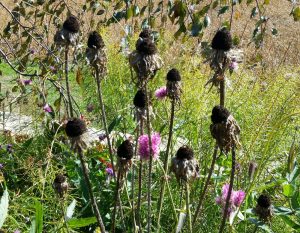As long as perennial plants are green, they are producing carbohydrates (food)  to be stored in the crown and roots for winter. Once the foliage turns yellow, and then brown, it is safe to cut off stems and leaves.
to be stored in the crown and roots for winter. Once the foliage turns yellow, and then brown, it is safe to cut off stems and leaves.
Each perennial plant goes dormant on its own schedule, so clean-up is not usually done in just one day. Rather, walk through the garden cutting back those that have turned, leaving the still-green plants to be cut back another day.
Cut back stems leaving 2-3″ so to not damage the crown. These short stems also serve as a marker to avoid accidental trampling. Foliage that is ready to be removed will pull easily from the clump making garden cleanup a snap.
Old flower heads may  contain seeds that feed birds through the winter. Members of the daisy family are especially good, such as Coneflower, Coreopsis, and Black-Eyed-Susans, but don’t disregard other perennials as a winter food source.
contain seeds that feed birds through the winter. Members of the daisy family are especially good, such as Coneflower, Coreopsis, and Black-Eyed-Susans, but don’t disregard other perennials as a winter food source.
Some perennials may have evergreen foliage, such as Liriope, Artemisia, and Heuchera. Remove foliage only as it looks dried out and discolored. New leaves will emerge next spring from the crown.
Shrubby perennials, like Butterfly Bush, Caryopteris, Lavender, Russian Sage, and Artemisia should have their stems cut back just before growth begins (mid-March). Cutting back before winter exposes plants to unnecessary winter damage. The old stems provide protection for next year’s buds.
